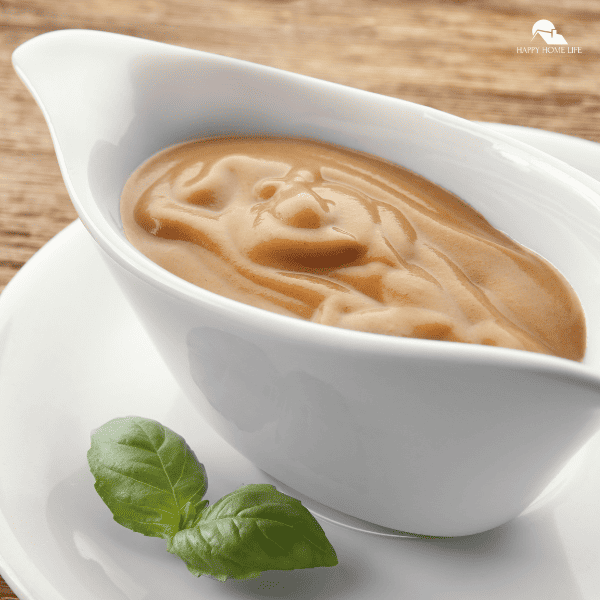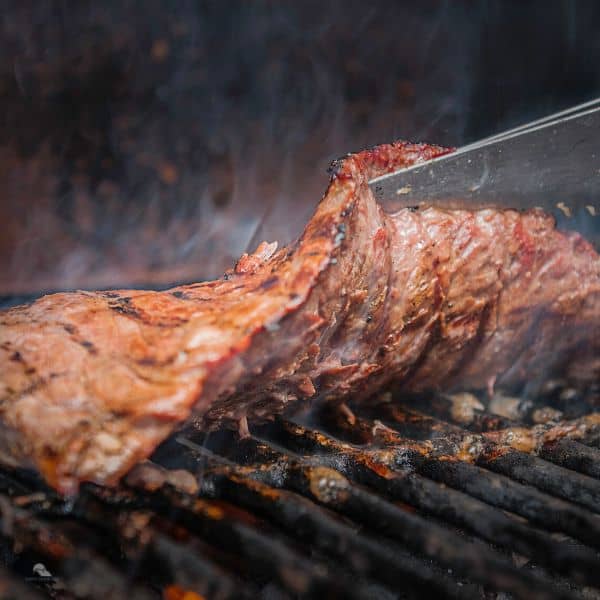Gravy – the delicious liquid often made from the juices of meat or vegetables – plays a crucial role in enhancing the flavor of various dishes. It adds richness, depth, and moisture, turning ordinary meals into extraordinary culinary experiences. But when it comes to serving this savory sauce, how much gravy per person should you put? Let’s explore the answer.

The crucial role of gravy in enhancing the flavor of dishes
According to statistics provided by Statista, 130.45 million American households used gravy and sauce mixes in 2020. It is not just a condiment; it’s a flavor enhancer. The savory liquid adds moisture and richness to meats, potatoes, vegetables, and other dishes. It brings together the flavors and textures, making every bite a delight. From roast chicken to Thanksgiving turkey, a well-made gravy can make all the difference.
Different types of gravies and popular preferences
Gravies come in various flavors and consistencies, depending on the main ingredient or recipe. Some popular types include beef gravy, chicken gravy, mushroom gravy, and vegetarian gravy. Preferences for the amount of gravy per person can vary. Some individuals prefer a generous amount to thoroughly drench their mashed potatoes and meats, while others prefer a lighter drizzle. It’s essential to consider guests’ preferences and provide options for them to customize their gravy servings.
The Importance of Planning
When it comes to serving delicious meals, planning is key. Whether you’re hosting a dinner party or a holiday gathering, having the right amount of gravy is essential. No one wants to run out or have an excessive amount left over. So, how much gravy should you prepare per person?
Understand the need for accurate measurements
Having accurate measurements ensures that you have enough gravy to go around without any wastage. It also ensures that everyone can enjoy their meal to the fullest. Too little gravy can leave your guests wanting more, while too much can be overwhelming.
Factors to consider when calculating the amount of gravy per person:
- Serving size: Consider the portion size of your main dish. A larger main dish may require more gravy, while a smaller portion may require less.
- Guest preferences: Take into account whether your guests tend to enjoy a generous amount of gravy or prefer a lighter serving.
- Accompaniments: Consider the side dishes that will be served with the main course. Gravy is often drizzled over items like mashed potatoes, stuffing, or vegetables. Take into account the quantity of these accompaniments.
- Leftovers: If you want to have leftovers or plan to serve gravy with additional meals, factor in the desired quantity.
By considering these factors and adjusting the quantity of gravy accordingly, you can ensure that each person has an enjoyable dining experience without any shortage or excess.
How Much Gravy Per Person?
Here are some guidelines to help you plan accordingly:
| Group Size | Gravy Needed (in cups) |
| 2 | 0.5 – 1 |
| 5 | 1.25 – 2.5 |
| 8 | 2 – 4 |
| 12 | 3 – 6 |
| Over 12 | Adjust accordingly |
For groups larger than 12, you can adjust the amount of gravy needed by continuing to follow the 1/4 to 1/2 cup per person rule.
To avoid any gravy-related mishaps, it’s important to plan and prepare accordingly. Consider the number of guests you will be serving and their preferences for gravy. As a general guideline, estimate about ½ cup to ¾ cup of gravy per person. This should provide enough for generous servings and potential second helpings.
While this measurement can vary depending on personal preferences and the types of dishes being served, it’s better to have a little extra than not enough. If you’re hosting a large gathering, consider doubling the amount to be on the safe side.

What is the formula for gravy?
Let’s say you’re hosting a Thanksgiving dinner for 20 people. Based on the guidelines mentioned earlier, you can estimate that you’ll need about 3/4 to 1 cup of gravy per person. Taking an average of 7/8 cups per person, you would need approximately 17.5 cups of gravy in total. It’s always a good idea to make a little extra to account for everyone’s preferences!
Check out our all-time gravy favorites!
Classic Beef Gravy
What makes classic beef gravy truly special is the process of creating it. Often referred to as pan drippings, the juice leftover from cooking meat contains all the delicious flavors that have been released during the cooking process. By combining these pan drippings with other ingredients and simmering them together, you end up with a velvety smooth sauce bursting with umami flavors.
Easy Homemade Chicken Gravy
If you’re tired of using store-bought gravy mixes or spending hours slaving away in the kitchen, then easy homemade chicken gravy is just what you need. Made from simple ingredients that you likely already have in your pantry, this gravy is a game-changer for any weeknight meal.
Mushroom Gravy
Mushroom gravy is a delightful and versatile sauce that can elevate any dish to new heights. Made with the rich umami flavors of mushrooms, this gravy adds depth and complexity to both vegetarian and non-vegetarian meals. What sets mushroom gravy apart is its ability to bring out the earthy essence of mushrooms while creating a velvety smooth texture.
Vegetarian Gravy
One of the advantages of vegetarian gravy is that it can be easily customized to suit individual tastes. From the choice of vegetables used in the base to the selection of herbs and spices added for enhanced flavor, this versatile sauce allows for creative experimentation in the kitchen. Whether you prefer a classic onion and garlic base or desire more complexity with earthy mushrooms or roasted vegetables, there are endless possibilities when it comes to crafting your perfect vegetarian gravy.
Tips for Making Delicious Gravy
Making delicious gravy is an essential skill that can elevate any meal. Whether you’re serving it alongside Thanksgiving turkey or topping mashed potatoes, mastering the art of gravy-making is worth the effort. The process typically involves thickening a flavorful liquid base with a thickening agent to create a smooth and creamy sauce.
Common gravy bases include meat drippings, stock, or broth. While the traditional method involves using pan drippings from roasted meat, you can also make vegetarian and vegan gravies using vegetable stock or mushroom broth as a base.
Tips and tricks to ensure a flavorful and satisfying gravy
- Use the right ratio of liquid to thickening agent: The key to achieving the perfect consistency is to strike the right balance between the liquid and the thickening agent. A general rule of thumb is to use 2 tablespoons of fat or butter, 2 tablespoons of flour, and 1 cup of liquid for a medium consistency.
- Add flavor-enhancing ingredients: To create a rich and flavorful gravy, consider adding ingredients like onions, garlic, herbs, or spices. Sauteing these ingredients with the fat before adding the flour can infuse the gravy with extra depth of flavor.
- Strain for a smooth texture: For a silky smooth gravy, strain it through a fine-mesh sieve to remove any lumps or solids.
- Adjust seasoning: Taste the gravy before serving and adjust the seasoning as needed. Add salt, pepper, or other seasonings to enhance the flavor to your preference.
- Keep warm until serving: To ensure that your gravy doesn’t cool and form a skin before serving, keep it warm over low heat or in a heatproof serving dish over a pan of hot water.

By following these tips and tricks, you can create a delicious and satisfying gravy that will complement any dish. Likewise, ensuring you have enough gravy to go around during a meal is essential to provide a delicious and satisfying dining experience.
Remember to factor in any dietary restrictions or preferences, as some guests may require more or less gravy than others. By taking these into account and planning accordingly, you can ensure a successful and satisfying meal where everyone gets to enjoy their favorite gravy to their heart’s content.






